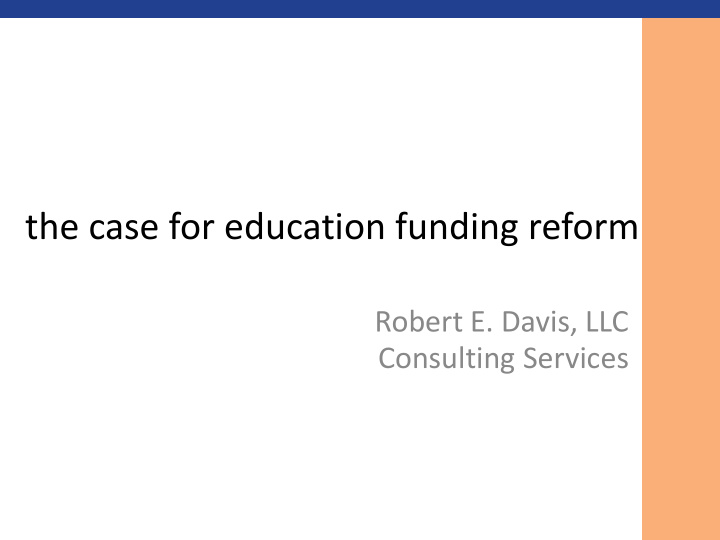



the case for education funding reform Robert E. Davis, LLC Consulting Services
state funding • education finance act (EFA) • education improvement act (EIA)
education finance act (EFA) • passed in 1977 • cornerstone of state funding • national model for funding education • has served us well for four decades • does need to be updated
EFA criteria • number of students • relative wealth of district (property values) • inflation
base student cost (BSC) • funding level necessary for providing a (“minimum” foundation program) • BSC is also predicated on a participation ratio of state 70% / local 30% YEAR STATE LOCAL TOTAL 70% 30% BSC 2014-2015 $1,483 $ 636 $2,119
base student cost • BSC should be at $2,700+
average daily membership (ADM) • aggregate number of days enrolled divided by the number of days school is in session. Student Days Days of ADM Enrolled School 1 135 135 1.0 2 108 135 0.8 3 121 135 0.9 4 27 135 0.2 Total 391 540 2.9
weighted pupil units (WPU) Student ADM EFA Weighting WPU Code (ADM X Weighting) 1 1.0 EL 1.00 1.00 2 0.8 HS 1.25 1.00 3 0.9 P 1.24 1.16 4 0.2 VH 2.57 .51 Total 2.9 3.67
FUNDING SOURCES State, Local & Federal Federal 7% State Local 54% 39%
act 388 property tax impact to homeowners • 100% of the fair market value exempt from property taxes for school operations • property taxes collected for school bonded debt NOT exempt changes to school district funding • districts reimbursed from the homestead exemption fund (HEF) by statewide sales tax collections • subsequent years, aggregate reimbursements are increased by Consumer Price Index plus population growth in the state • reassessment cap limited to 15% increase in 5 years
act 388 millage cap • caps are in place for all local governing bodies • millage may be increased only by CPI plus the population growth of the entity from the prior year • cap may only be exceeded with 2/3 vote of the local governing body and only for the following reasons: deficiency from previous year national disaster/act of terrorism court order close of a business that decreases tax revenues by more than 10% un-funded state or federal mandate
act 388 concerns • growing school districts revenues per student new school start-up costs • index of taxpaying ability (ITA) • funding inequities among similar size districts • limitation imposed on local funding and the volatility of sales tax revenues
school board taxing authority • limited authority - 27 districts • autonomy - 26 districts • no authority - 25 districts • statutory cap - 3 districts 81 districts
more changes • EOC, governor’s WPU: 1.0 with add -ons poverty disabilities limited English adult (17-21) remediation vocational/career gifted and talented • decrease selected special revenue funds • increase funding for technology (one-time)
a plan to restructure education funding
• equalize, simplify state K-12 spending in reasonable, realistic manner • level and stabilize the tax burden playing field • strengthen state-local education partnership with greater transparency, accountability
how it works …
additional state dollars needed to make up or balance the difference between school revenues generated from current property taxes versus revenues that the 100-mill levy (SUM) would generate estimate: $600 million
reduces about 70 separate state funding sources to 12
additional state funding to ensure no district gets less funds than what it currently receives – “hold harmless” Est. $340 million
all other funds for programs not distributed to districts on per pupil basis such as: » transportation related » national board certification » palmetto priority schools » retiree insurance » 4K programs
local school board authority (fiscal autonomy) to levy millage of up to 8% of the assessed value of taxable properties
local school boards can have option to go above 8% but must get voter approval. If approved, funding applies to all property including homestead
local district examples…
Kershaw County School District actual FY 2009-10 funding $ 63,362,433 EOC WPU 13,380 est. funding based on BSF $5,295 $ 70,852,479 additional funds (phase-in over 3 years) $ 7,490,046 local taxpayer savings (154 to 100 mills) $ 6,652,938 school board 8% authority $ 8,847,235 *non-rolled up state revenue will be added to the figures above
Georgetown County School District actual FY 2009-10 funding $ 71,914,493 EOC WPU 12,792 est. funding based on BSF $5,295 $ 67,737,754 transitional funds (phase-out over 25 years) $ 4,176,739 local taxpayer savings (99 to 94 mills) $ 3,319,032 school board 8% authority $ 32,437,517 *non-rolled up state revenue will be added to the figures above
other major provisions…
• annual inflation factor: state salary schedule, step and benefits increases • reserves: state – 5% district – 15% • transition new revenue to low revenue districts – phase-in over 3 years transition funds – phase-out over 25 years (4% per year)
what will it take to make scjet a reality?
$ 300 million + $ 600 million balancing funds $ 900 million total additional state funds needed grant $600 million in tax relief for all business, industries ,vehicles and all other property taxpayers funding is well within the state’s capability
court ruling key points • Abbeville vs South Carolina – decades old school funding lawsuit • cited funding system as “patchwork” • who bears responsibility? legislature and school districts
time is right for funding reform? Honorable Jenny Horne South Carolina House of Representatives
Recommend
More recommend